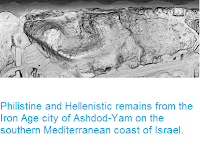The ancient city of Meroe was located on the east bank of the River Nile, about 200 km to the north of Khartoum in modern Sudan. It was the capitol of the Kingdom of Kush from about 300 BC onwards, and excavations at the site have revealed an extensive network of highly decorated temples and palaces. The wealth of Meroe was built upon the production of iron, which began during the Napatan period of Kushite history (i.e. the period during which Kush was ruled from Napata, before rule of the kingdom was moved to wealthier Meroe). The geology of the area around Meroe is dominated by iron-rich sandstones, which are presumed to have been the source of the iron produced in the city, although this industry has not previously been the subject of archaeological investigations.
In a paper published in the journal Azania: Archaeological Research in Africa on 3 October 2018, Jane Humphris of UCL Qatar and Hamad ibn Khalifa University, Robert Bussert of the Institut für Angewandte Geowissenschaften at Technischen Universität Berlin, Fareed Alshishani of the American Center of Oriental Research, and Thomas Scheibner of Archaeological Research and Service, describe the initial results of an investigation into the ancient iron-works of Meroe that began in 2012.
The area to the east of Meroe is dominated by a tableland of plateaux where the Late Cretaceous Shendi Formation is exposed. This formation comprises cross-bedded or ripple cross-stratified, fine-to-medium-grained quartz sandstones and kaolinitic mudstones, laid down in alluvial to shallow marine environments of a low-gradient coastal plain. These deposits tend to accumulate iron in their upper layers, which take on a dark-brown to black colour.
The area to the east of Meroe is dominated by a tableland of plateaux where the Late Cretaceous Shendi Formation is exposed. This formation comprises cross-bedded or ripple cross-stratified, fine-to-medium-grained quartz sandstones and kaolinitic mudstones, laid down in alluvial to shallow marine environments of a low-gradient coastal plain. These deposits tend to accumulate iron in their upper layers, which take on a dark-brown to black colour.
A plateau area to the east of Meroe, with a seasonal wadi bed marked by small outcrops of vegetation. Humphis et al. (2018).
Humphis et al. carried out investigations at a site identified as MMA 1, to the northeast of Meroe, where several in-filled depressions were found, which superficially resemble similar depressions at Timna in southern Israel, where archaeologists discovered ancient mine-shafts dug by copper miners. The people of Meroe are known to have had the technology to dig deep pit mines, as they dug deep wells, tunnel systems beneath their temple-complexes, and excavated gallery-mines to obtain stone for building. However investigation of the depressions found that they were in fact shallow pits, with material excavated from the digging work piled around their edges, which had then acted as sediment traps for wind-blown material.
Overview photograph of trench at MMA 1, with sediment traps visible in the background and the trench running through sediment traps of differing depths in the foreground. Humphis et al. (2018).
A variety of artefacts were found at the site, including bricks and brick fragments, iron slag, pottery and a fragment of a stone statue. Some of the bricks had traces of plaster upon them, which suggests that the mine-workings included permanent structures used by people of some status. The pottery fragments were extremely limited compared to the other material, suggesting that pottery was not the main material used for carrying; Humphris et al. suggest that, given the environment, and the need to ship goods to and from the city of Meroe, baskets or animal-skins would have been more suited to this purpose anyway. The statue fragment appears to be part of a figurine wearing clothing resembling that worn by kings, queens and gods in statues seen in Meroe, and may be indicative worship being carried out on the plateau.
The stone fragment of a statue found at MMA 1. Bogumil Pilarski in Humphis et al. (2018).
A variety of iron-rich sediments were found on the plateau, though the highest concentrations of iron were found in the black duricrust at the surface, where iron is concentrated by the weathering of other minerals, which may explain why the ancient miners produced only shallow excavations. A variety of iron-ores were present, including goethite and haematite, as well as ferricretes and oolitic ironstones. Oolitic ironstones mainly consist of goethite and minor haematite and are surrounded by a fine-grained matrix of finely crystalline iron minerals, predominantly goethite. Such sediments form in wave-dominated inshore environments where the minerals are being precipitated out of the water onto grains beings moved constantly by the currents rather than settling on the seafloor where they would fuse together. At the MMA 1 site these oolites are often concentrated in lenses in depressions thought to be ancient sinkholes, formed by the collapse of caves beneath the surface, which are then topped by ferricretes, which could be used as an indicator of a source of high-grade ore. Experimental smelting of these oolitic ironstones by two experienced smelters, Lee Sauder of the Germinal Ironworks in Virginia, USA, and Jake Keen of the Ancient Technology Centre in Cranborne, UK, yielded better results than any other ore in the vicinity, work that is ongoing as the team attempt to reconstruct the methods used in ancient Meroe.
Thin section photomicrograph under plane polarised light of an oolitic ironstone sample from MMA 1 showing spherical, ellipsoidal and partly broken iron ooids in a fine-grained goethitic matrix. Humphis et al. (2018).
See also...
Follow Sciency Thoughts on Facebook.










